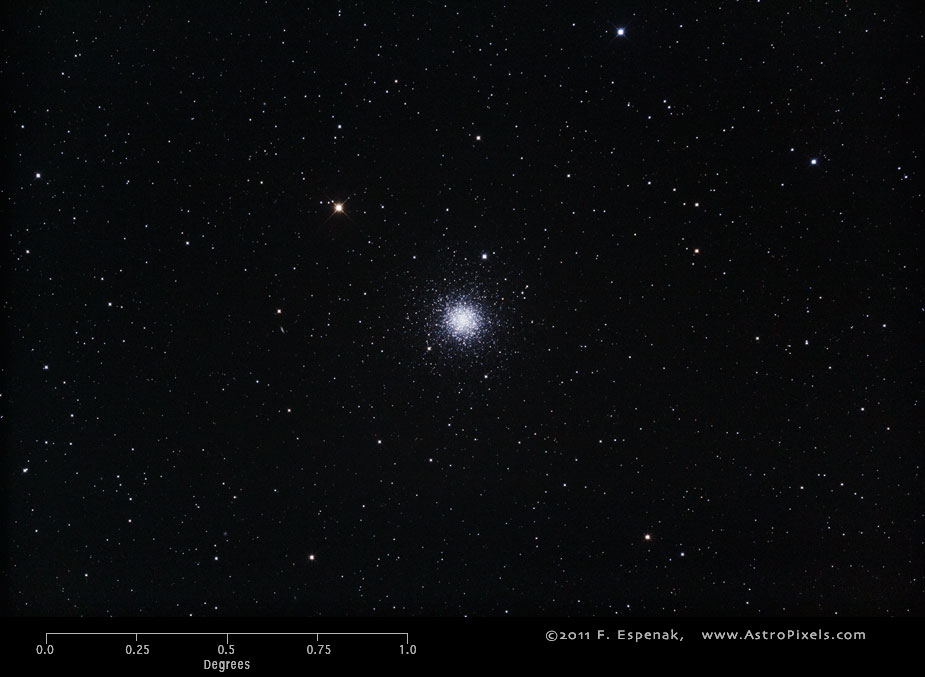
M3
Messier 3 or M3 (also designated NGC 5272) is a globular cluster in the constellation Canes Venatici. It has an apparent visual magnitude of 6.2 and its angular diameter is 16.2 arc-minutes. M3 lies at an estimated distance of 33,900 light years. The Equinox 2000 coordinates are RA= 13h 42.2m, Dec= +28° 23´ which makes M3 best seen during the spring. The Messier Spring Star Chart shows the position of all Messier objects visible during that season.
The image above shows the uncropped view of M3 through the Takahashi E-180 Astrograph (North is up). A 3x enlargement of this image appears to the right.
For higher magnification view of this object using the ASA N12 Corrected Newtonian Astrograph, see M3 (ASA N12) .
M3 was the first object in the Messier Catalog that Charles Messier discovered (on May 3, 1764). It spurred the comet hunter to make a more systematic search for comet-like objects that were not comets. By the end of the year, Messier had compiled a list of 40 objects for his catalog. Messier described M3 as a starless nebula. It wasn't until around 1784 that M3 was first resolved into individual stars by William Herschel.
M3 is one of the largest globular clusters and contains about half a million stars. According to Recio-Blanco et al.(2005), the distance of M3 is 34,170 light years and its diameter is 190 light years. Its estimated mass is 800,000 solar masses and it contains 274 variable stars. The distance of M3 places it further away than the center of the Milky Way Galaxy. Nevertheless, it shines with the luminostity of 300,000 Suns. The estimated age of M3 is 8 billion years.
For more information, see the Messier Catalog as well as specific entries for M3 in Wikipedia and SEDS.
Messier's Description of M3
May 3, 1764
`Nebula discovered between Bootes and one of the Hunting Dogs of Hevelius [Canes Venatici]. It doesn't contain any stars, its center is brilliant, and its light is gradually fading away, it is round; in a good sky, one can see it in a telescope of 1 foot: It is reported on the chart of the comet observed in 1779. Memoirs of the Academy of the same year. Reviewed on March 29, 1781, always very beautiful. (Diam. 3')'
Technical Details
- Object: M3
- Other Names: NGC 5272
- Object Type: globular cluster
- Object Data: Apparent Magnitude = 6.2, Angular Size = 16.2 arc-minutes
- Object Position (Equinox 2000): RA= 13h 42.2m, Dec= +28° 23´, Constellation = Canes Venatici
- Date/Time: 2011 Mar 29 at 07:40 UTC
- Location: Bifrost Astronomical Observatory, Portal, AZ
- Mount: Astro-Physics 1200GTO
- Telescope: Takahashi Epsilon 180 Hyperbolic Astrograph
- Camera: Canon EOS 550D (Rebel T2i) (modified with a Baader UV/IR filter)
- Field of View: 1.70° x 2.56° at 1.7 arc-sec/pixel (web version: 10.0 arc-sec/pixel)
- Exposure: 2 x 300s, f/2.8, ISO 800
- File Name: M3-01w.jpg
- Processing (Adobe Camera Raw): Graduated Filter, Vignetting Correction, Noise Reduction, White Balance, Curves
- Processing (Photoshop CS5): Average Images, Curves, Noise Reduction
- Original Image Size: 3454 × 5179 pixels (17.9 MP); 11.5" x 17.3" @ 300 dpi
- Rights: Copyright 2011 by Fred Espenak. All Rights Reserved. See: Image Licensing.
